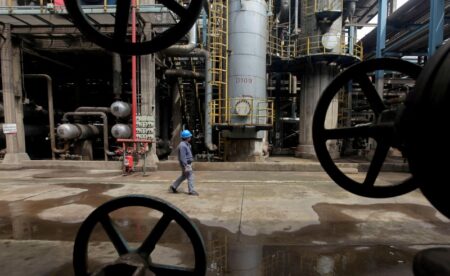LONDON (Reuters) – Copper has rallied hard this week as China’s pledged stimulus package has rekindled investor enthusiasm.
Renewed optimism that the world’s largest buyer can recover its lost manufacturing momentum has propelled London Metal Exchange (LME) three-month metal above the $10,000-per metric ton level for the first time since July.
The turn in macro sentiment has been mirrored by a positive shift in market optics as Shanghai copper stocks have trended sharply lower in recent weeks.
However, copper bulls may be getting ahead of themselves.
There’s no shortage of copper, according to the International Copper Study Group (ICSG), which has just updated its supply and demand forecasts for this year and next.
Indeed, the ICSG expects a hefty 469,000-ton global supply surplus this year followed by another 194,000-ton surplus in 2025. The scale of oversupply is more than double that forecast when the Group last met in April.
SUPPLY OUTPERFORMS
The ICSG forecasts come with statistical caveats, most notably that the Group’s calculation of apparent demand in China is based only on reported data such as stock levels and trade flows.
The methodology cannot capture shifts in strategic or commercial inventories which can be hugely important in determining the actual market balance.
But the Group’s increased surplus forecasts for 2024 and 2025 are almost entirely due to changes on the supply side, the far more transparent part of the equation.
Expected copper mine production growth of 1.7% in 2024 will fall just short of last year but is a significant upgrade from the 0.5% forecast in April.
The ICSG expects the growth rate to accelerate to 3.5% next year as big mines such as Kamoa-Kakula in the Congo and Oyu Tolgoi in Mongolia ramp up capacity and the new Malmyzhskoye mine in Russia enters production.
Refined metal production is now expected to grow by 4.2% this year, another upgrade from April, when the ICSG forecast growth of 2.8%.
TIGHT CONCENTRATES MARKET
The mismatch between the rate of mine and smelter production growth is squeezing the raw materials segment of the copper market.
Spot treatment charges, levied by smelters for converting mined concentrates into refined metal, are close to zero.
The squeeze on smelter profitability has fuelled a bull narrative of copper scarcity but that misses the point that low treatment charges also reflect an aggressive expansion of copper smelting capacity, particularly in China.
Chinese smelters announced plans to reduce run-rates in March but the effect has been to slow not reverse production growth. National output of refined metal was still up by 6.2% year-on-year in the first eight months of 2024.
The country’s top producers are again calling for collective restraint. Whether this has any tangible impact on actual production levels remains to be seen.
METAL SURPLUS
While there is genuine tightness in the raw materials supply chain, there is clearly no shortage of copper.
Global exchange stocks touched a four-year high of 599,000 tons at the end of August. Even after a 100,000-ton decline so far this month, they are still 284,000 tons higher than at the start of 2024.
Global surplus has been masked by regional tightness.
Low inventory and an acute squeeze on the CME contract in May reflected the U.S. exchange’s limited physical delivery options rather than global scarcity.
CME stocks are now rising at a fast clip but only after a convoluted physical arbitrage that saw Chinese smelters ship metal to LME warehouses because none of them have a direct CME delivery option.
China exported 332,000 tons of refined copper in the May-August period, which is likely why Shanghai stocks are now sliding.
BULL HOPES REST ON DEMAND
This week’s price rally has been all about China and the renewed optimism surrounding its copper demand outlook.
The ICSG hasn’t changed its views on that since April, forecasting Chinese copper usage to grow by a relatively modest 2.0% this year and by 1.8% in 2025.
The Group expects the rest of the world to fare better after a 3.0% contraction in demand last year.
But global demand growth of 2.2% this year will lag refined production growth by a significant margin, hence the expected metal glut.
It’s noticeable that the jump in the outright LME copper price hasn’t been matched by any movement in the forward spreads.
The LME cash-to-three-months time-spread continues to trade in wide contango. The cash discount was valued at $131 at Thursday’s close, a strong price signal the world is not running out of copper just yet.
Funds ignored similar market dynamics when they surged into the copper market in the second quarter. They left again in the third quarter as increased Chinese exports and rising inventory dispelled any illusion of scarcity.
They run the risk of repeating the same mistake in the current rally.
The opinions expressed here are those of the author, a columnist for Reuters
Read the full article here















